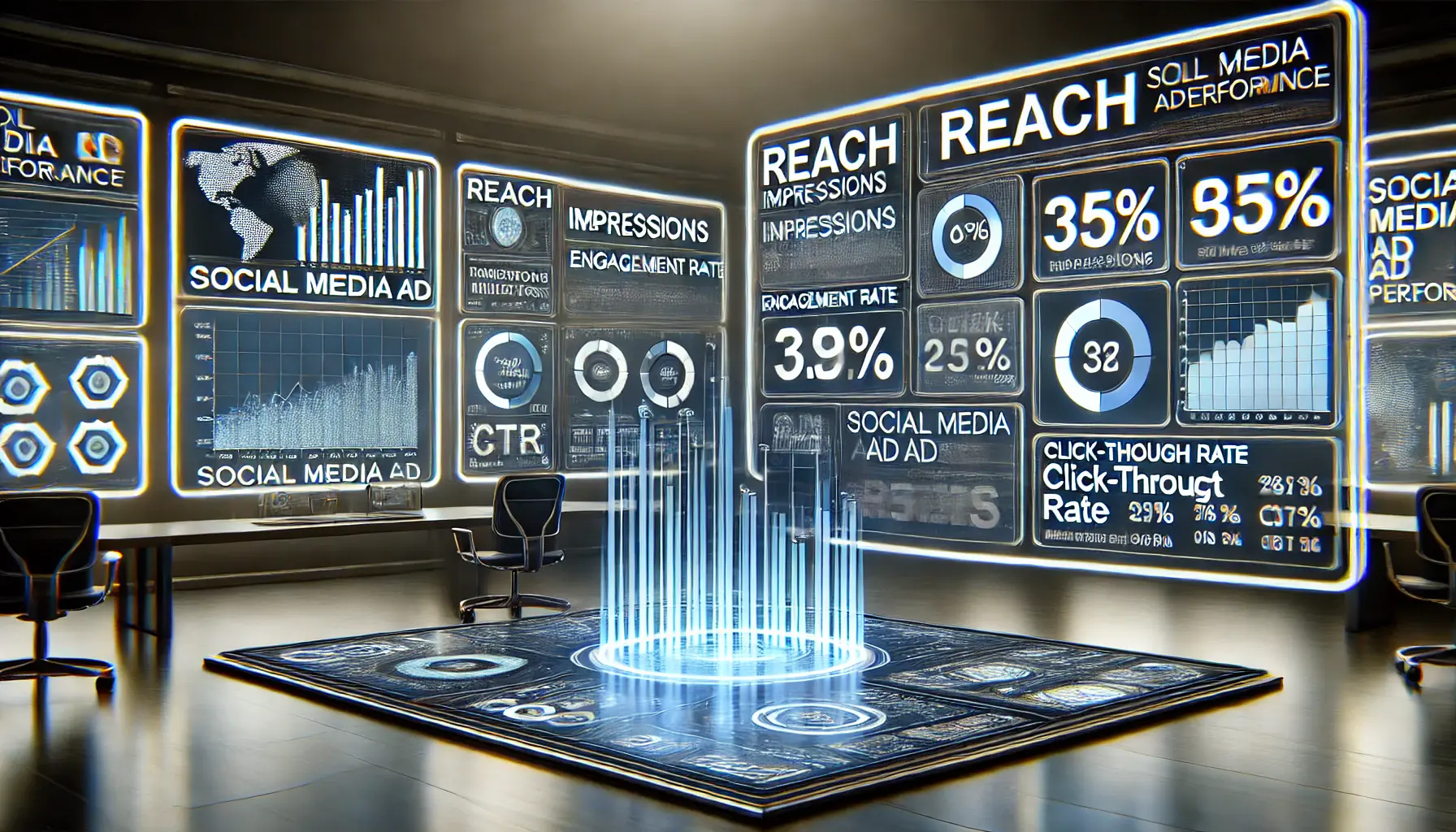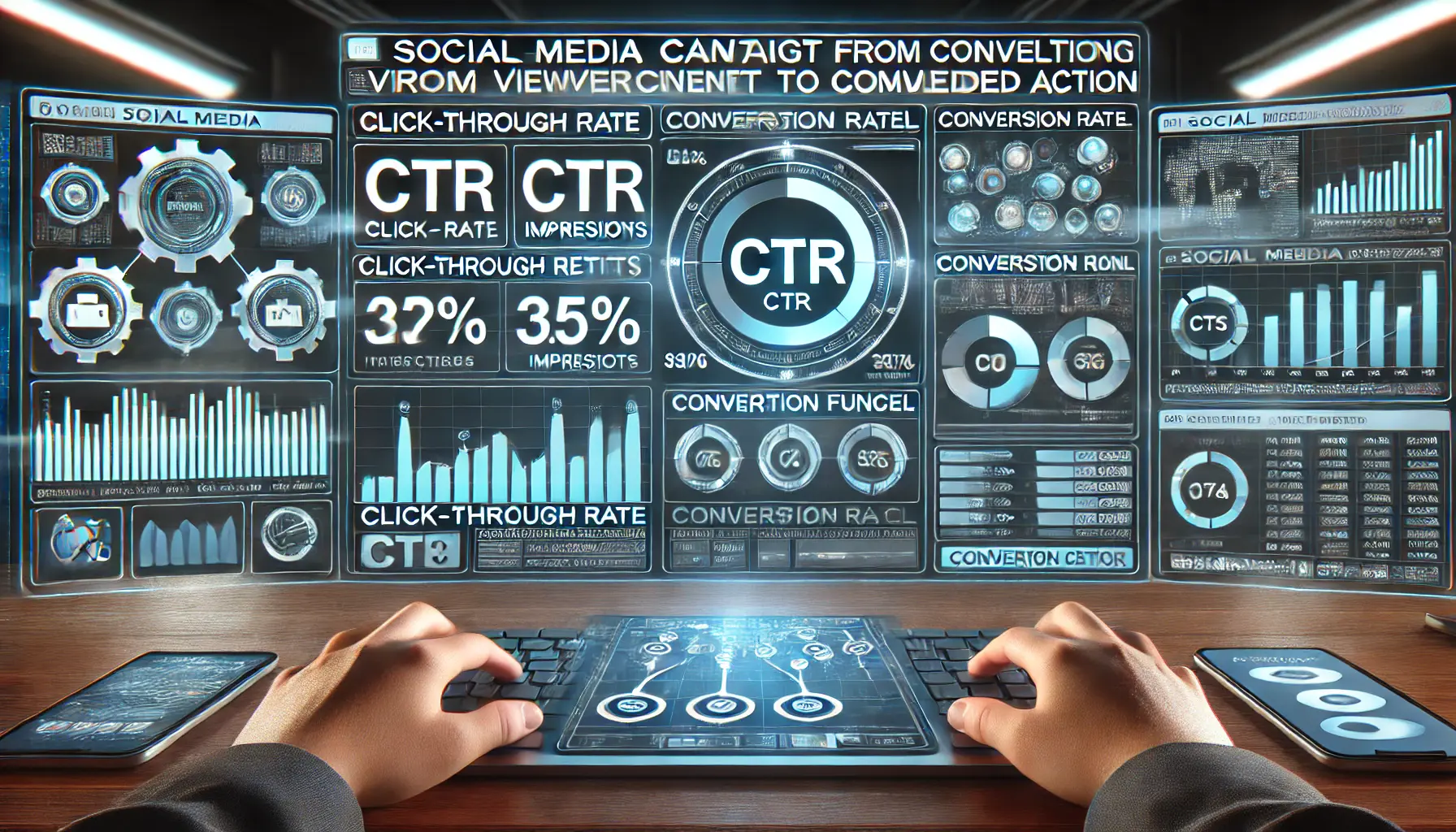In today’s digital landscape, understanding analytics and metrics is crucial for crafting effective social media advertising campaigns.
By delving into these insights, you can fine-tune your strategies, engage your audience more effectively, and ultimately achieve your marketing goals.
Let’s explore the foundational concepts of analytics and metrics in social media advertising.
- Understanding Analytics and Metrics in Social Media Advertising
- Essential Social Media Metrics to Track in 2025
- Tools and Techniques for Effective Social Media Analytics
- Strategies to Optimize Social Media Campaigns Using Analytics
- Future Trends in Social Media Analytics and Metrics
- Harnessing Analytics and Metrics for Social Media Success
- Frequently Asked Questions about Social Media Analytics and Metrics
Understanding Analytics and Metrics in Social Media Advertising
When navigating the realm of social media advertising, you need to understand the difference between analytics and metrics.
While the terms are often used interchangeably, they serve different purposes when evaluating campaign performance.

A modern workspace illustrating the contrast between raw data metrics and deep analytical insights.
Defining Key Terms: Analytics vs. Metrics
Metrics are specific, well-defined data points that measure various aspects of performance on social media.
Examples include the number of likes, shares, comments, and click-through rates.
These numbers provide a snapshot of how well your content is performing at a particular moment.
Analytics, on the other hand, involves interpreting these metrics to uncover patterns and insights.
It’s about understanding the ‘why’ behind the numbers.
For instance, analytics can reveal which types of content resonate most with your audience or the optimal times for posting.

A futuristic marketing control room showcasing the impact of analytics on campaign success.
The Role of Analytics in Campaign Success
Analytics plays a pivotal role in the success of social media campaigns.
By analyzing data, you can:
- Identify Audience Preferences: Understand what type of content your audience engages with the most.
- Optimize Posting Schedules: Determine the best times to post content for maximum reach.
- Measure ROI: Assess which campaigns provide the best return on investment.
- Refine Strategies: Use data-driven insights to improve future campaigns.

A high-tech workspace showcasing key social media ad metrics for performance tracking.
Common Metrics Used in Social Media Ads
Several key metrics are commonly used to evaluate the performance of social media advertisements:
- Reach: The total number of unique users who have seen your content.
- Impressions: The total number of times your content is displayed, regardless of clicks.
- Engagement Rate: The ratio of engagements (likes, comments, shares) to total reach, indicating how interactive your audience is with your content.
- Click-Through Rate (CTR): The percentage of users who, after seeing your post, clicked on its link.
- Conversion Rate: The percentage of users who, after clicking through your post, completed a desired action, such as making a purchase.
Understanding these analytics and metrics will help you gauge how well your ads are performing and identify areas for improvement.
By mastering the nuances of analytics and metrics in social media advertising, you can create campaigns that not only reach your audience but also engage and convert them effectively.
Understanding the difference between analytics and metrics is crucial for optimizing social media campaigns. While metrics provide raw data, analytics interpret that data to uncover patterns and insights that can drive strategic decisions.

A high-tech dashboard showcasing the evolving landscape of social media metrics in 2025.
Essential Social Media Metrics to Track in 2025
In the ever-evolving landscape of social media advertising, staying updated on the most relevant analytics and metrics is crucial for campaign success.
As we navigate through 2025, certain metrics have become essential for understanding and optimizing your social media strategies.
Let’s explore these key metrics and their significance.

A high-tech dashboard highlighting real-time social media engagement metrics.
Engagement Metrics: Likes, Shares, and Comments
Engagement metrics are primary indicators of how well your audience interacts with your content.
These include likes, shares, comments, and other forms of engagement.
Monitoring these metrics helps evaluate the effectiveness of your content in connecting with your audience.
- Likes: Immediate reflections of positive feedback from your audience.
- Shares: Indicate that users find your content valuable enough to distribute within their networks, increasing organic reach.
- Comments: Provide valuable feedback from the audience and can be used to refine future content strategies.
By analyzing these engagement metrics, you can identify which content resonates most with your audience and adjust your strategy accordingly.

A high-tech analytics dashboard visualizing reach and impressions for social media campaigns.
Reach and Impressions: Measuring Audience Exposure
Understanding how many people see your content is crucial for assessing its impact.
This is where reach and impressions come into play.
- Reach: The total number of unique users who have viewed your content. It helps determine the actual size of your audience.
- Impressions: The total number of times your content is displayed, regardless of clicks. This metric indicates how well your content is distributed.
Monitoring these analytics and metrics provides insights into your content’s visibility and helps guide decisions on promotion and timing.

A high-tech dashboard illustrating CTR and conversion rates in a social media campaign.
Click-Through Rate (CTR) and Conversion Rates
While engagement and exposure are important, most campaigns aim to drive specific actions, such as website visits or purchases.
This is where CTR and conversion rates become vital.
- Click-Through Rate (CTR): The percentage of users who click on your post’s link after seeing it. A high CTR indicates that your content effectively encourages users to take action.
- Conversion Rate: The percentage of users who complete a desired action, such as making a purchase, after clicking through your post. This metric directly reflects the campaign’s success in achieving its objectives.
Regularly tracking CTR and conversion rates allows you to assess the effectiveness of your call-to-action and overall campaign performance.

A modern digital workspace illustrating sentiment analysis for customer satisfaction metrics.
Customer Satisfaction Metrics: Sentiment Analysis
Beyond quantitative measurements, it’s important to analyze qualitative elements of audience engagement.
Sentiment analysis helps measure customer satisfaction by evaluating the emotions conveyed in user interactions.
- Sentiment Analysis: Examines comments and feedback to determine whether the perception of your brand is positive, negative, or neutral.
Incorporating sentiment analysisA process that uses natural language processing to determine the emotional tone of text data, often applied to customer feedback. into your analytics and metrics provides a comprehensive understanding of audience perception and enables improvements in customer relationships and content strategies.
By focusing on these crucial analytics and metrics, you can gain valuable insights into your social media campaign’s effectiveness and make data-driven decisions to enhance its performance.
As digital trends evolve, tracking advanced metrics such as customer lifetime valueA metric that estimates the total revenue a business can expect from a single customer throughout their relationship. and audience retention will become essential for measuring long-term social media success.

A modern digital workspace highlighting the use of advanced tools and techniques for social media analytics.
Tools and Techniques for Effective Social Media Analytics
In the dynamic world of social media advertising, leveraging the right tools and techniques is essential for gaining actionable insights from your analytics and metrics.
As we progress through 2025, several advanced platforms and methodologies have emerged to enhance the effectiveness of social media analytics.
Let’s explore some of the top tools and innovative techniques that can elevate your campaign performance.

A high-tech digital workspace featuring top social media analytics platforms for campaign optimization.
Top Analytics Platforms for Social Media Campaigns
Choosing the appropriate analytics platform is crucial for accurately measuring and interpreting your social media metrics.
Here are some leading platforms that have gained prominence:
- Sprout Social: Offers comprehensive analytics and reporting features, enabling you to track engagement, audience demographics, and content performance across multiple social media channels.
- Hootsuite: Provides in-depth analytics tools that monitor the effectiveness of your social media campaigns, measuring key metrics such as reach, clicks, and conversions.
- Buffer: Known for its user-friendly interface, Buffer offers detailed insights into post-performance, audience engagement, and optimal posting times.
Utilizing these tools will streamline your analytics and metrics process by offering real data-driven insights to improve your social media strategies.

A high-tech workspace showing the integration of AI and machine learning in social media analytics.
Implementing AI and Machine Learning in Analytics
Artificial Intelligence (AI) and Machine LearningA subset of artificial intelligence that enables computer systems to improve performance on tasks by learning from data. (ML) are revolutionizing social media analytics by offering deeper insights and predictive capabilities.
Here’s how they are being applied:
- Predictive Analytics: AI algorithms analyze historical data to forecast future trends, helping you anticipate audience behavior and adjust your campaigns proactively.
- Sentiment Analysis: ML models analyze user-generated content to determine public sentiment toward your brand, enabling real-time reputation management.
- Content Optimization: AI-powered tools suggest content improvements by analyzing engagement patterns, ensuring your posts are highly relevant to your audience.
Integrating AI and ML into your analytics and metrics strategy helps improve content performance and refine audience targeting.

A high-tech digital workspace featuring advanced data visualization tools for better insights into social media performance.
Data Visualization Techniques for Better Insights
Effectively visualizing your analytics and metrics is key to understanding and communicating your social media performance.
Consider the following techniques:
- Interactive Dashboards: Utilize platforms that offer customizable dashboards, allowing you to monitor key metrics in real-time and adjust strategies accordingly.
- Heat Maps: Identify the most engaged areas on your social media pages to optimize content placement and improve layout decisions.
- Trend Lines: Track performance metrics over time to detect patterns and assess the effectiveness of your campaigns.
Embracing advanced tools and techniques in your social media analytics empowers you to unlock the true potential of your data, leading to more effective campaigns and a deeper understanding of your audience.
Using advanced analytics tools like Sprout Social and AI-powered predictive analyticsA branch of data analytics that uses statistical techniques and machine learning to forecast future trends and outcomes. can provide deeper insights, improving campaign efficiency.

A high-tech digital workspace highlighting strategies for optimizing social media campaigns through data-driven analytics.
Strategies to Optimize Social Media Campaigns Using Analytics
In today’s competitive digital landscape, effectively utilizing analytics and metrics is essential for optimizing your social media campaigns.
By leveraging data-driven insights, you can refine your strategies to enhance engagement, increase reach, and achieve your marketing objectives.
Let’s explore key strategies to harness the power of analytics in your social media endeavors.

A modern digital workspace emphasizing the importance of setting goals and tracking KPIs for social media campaign success.
Set Clear Goals and Key Performance Indicators (KPIs)
Define your social media campaign objectives using the SMART framework: specific, measurable, achievable, relevant, and time-bound.
Align these with your overall business objectives and establish KPIs to track performance.
Common KPIs include:
- Engagement Rate: Measures the level of audience interaction with your content.
- Click-Through Rate (CTR): Indicates the effectiveness of your call-to-action.
- Conversion Rate: Assesses the percentage of users who complete a desired action after engaging with your content.
Setting clear goals and KPIs provides a roadmap for your campaigns and facilitates the evaluation of success through relevant metrics.

A high-tech digital workspace featuring audience demographic and behavioral analysis for social media campaigns.
Analyze Audience Demographics and Behavior
Knowing your audience is crucial to creating content that resonates.
Use analytics tools to capture data on audience demographics, such as age, gender, location, and interests.
Additionally, review behavioral data to understand the following:
- Peak Activity Times: Identify when your audience is most active to optimize posting schedules.
- Content Preferences: Determine which types of content (videos, images, articles) generate the most engagement.
- Platform Usage: Identify which social media platforms your target audience frequents the most.
By tailoring your content strategy based on these insights, you can enhance engagement and foster stronger connections with your audience.

A high-tech digital workspace for analyzing and monitoring competitor performance in social media campaigns.
Monitor Competitor Performance
Keeping an eye on competitors’ social media activities can provide valuable insights.
Analyze their content strategy, engagement rate, and audience interaction to identify:
- Popular Content Themes: Recognize which topics appeal most to your target audience within your industry.
- Engagement Strategies: Observe how competitors encourage audience participation.
- Posting Cadence: Assess how frequently competitors post and the consistency of their content.
Learning from your competitors’ successes and challenges helps you refine your strategy and identify opportunities to stand out.

A modern digital workspace for optimizing content using A/B testing in social media campaigns.
Leverage A/B Testing to Optimize Your Content
A/B testing involves creating two versions of content to determine which performs better.
Consider testing the following elements:
- Headlines: Experiment with different headline styles to attract attention.
- Visuals: Compare the effectiveness of different images or videos.
- Call-to-Action Phrases: Test various CTAs to see which drives the most engagement.
By systematically testing and analyzing results, you can optimize your content for better performance based on real metrics.

A high-tech digital workspace illustrating the ongoing process of refining social media strategies through analytics.
Regularly Review and Refine Your Strategy
Social media trends and audience behaviors constantly evolve.
Regularly review your analytics data to evaluate campaign effectiveness.
Identify patterns in your metrics to determine areas for improvement.
Be ready to adjust your strategy based on:
- Shifting Audience Preferences: Stay informed about changes in audience interests to remain relevant.
- Platform Algorithm Updates: Adapt to changes in how social media platforms prioritize content.
- Results from New Content Formats: Experiment with innovative content types and evaluate their impact.
Being flexible and responsive to analytics and metrics insights ensures the continued effectiveness of your social media campaigns and alignment with your marketing goals.
By implementing these strategies, you can maximize the impact of analytics and metrics in optimizing social media campaigns, driving engagement, and achieving meaningful results.
Regularly refining content strategies based on analytical insights ensures sustained engagement and improved conversion rates over time.

A high-tech digital workspace visualizing the future of social media analytics and metrics through AI and machine learning insights.
Future Trends in Social Media Analytics and Metrics
As we look ahead, the landscape of social media analytics and metrics is poised for significant transformation.
Staying informed about emerging trends is crucial for marketers aiming to maintain a competitive edge.
Let’s explore the key developments shaping the future of social media analytics.

A high-tech digital workspace visualizing the role of AI and machine learning in enhancing social media analytics and decision-making.
Integration of Artificial Intelligence and Machine Learning
The integration of AI and machine learning is revolutionizing social media data analytics.
These technologies make data analysis more sophisticated, enable predictive modeling, and automate insights.
For example, AI-powered sentiment analysis helps brands understand consumer emotions more accurately, allowing them to develop targeted strategies.
The result is more personalized and effective marketing campaigns.

A modern digital workspace emphasizing the integration of real-time data and predictive analytics in social media marketing.
Emphasis on Real-Time Data and Predictive Analytics
In the fast-paced world of social media, real-time dataInformation that is processed and available for analysis immediately after collection, without significant delay. analysis has become indispensable.
Marketers are increasingly leveraging real-time analytics to monitor campaign performance and audience engagement as they happen.
Additionally, predictive analytics, powered by AI, allows brands to anticipate trends and consumer behaviors, enabling proactive strategy adjustments.
This approach ensures that marketing efforts remain relevant and impactful.

A high-tech digital workspace emphasizing the importance of privacy and data ethics in social media analytics.
Focus on Privacy and Data Ethics
With growing concerns over data privacy, ethical data collection and analysis are becoming more important than ever.
Marketers must navigate evolving regulations and consumer expectations by implementing transparent data practices and prioritizing user consent.
Building trust through ethical data handling not only ensures compliance but also enhances brand reputation and customer loyalty.

A high-tech digital workspace featuring advanced sentiment analysis tools for social media analytics.
Adoption of Advanced Sentiment Analysis Tools
Understanding consumer sentiment is becoming more nuanced with the adoption of advanced sentiment analysis tools.
These tools go beyond basic positive or negative classifications, providing deeper insights into consumer emotions and opinions.
By analyzing language subtleties and context, brands can better understand audience perceptions and refine their messaging to resonate more effectively.

A high-tech digital workspace visualizing the use of social listening tools to gain strategic insights in marketing.
Utilization of Social Listening for Strategic Insights
Social listening has evolved into a powerful tool for gathering insights beyond brand mentions.
Monitoring conversations across social platforms allows brands to identify emerging trends, understand consumer needs, and gather competitive intelligence.
This proactive approach enables brands to make informed decisions and stay ahead of market shifts.
Embracing these future trends in social media analytics and metrics will lead to more targeted, effective, and ethical campaigns, ensuring continuous success in the ever-changing digital landscape.
AI-powered analytics, real-time tracking, and ethical data practices will shape the future of social media marketing, making adaptability a key success factor.

A high-tech digital workspace visualizing the use of analytics and metrics to drive social media campaign success.
Harnessing Analytics and Metrics for Social Media Success
In the fast-paced world of digital marketing, leveraging analytics and metrics is no longer optional—it’s essential.
The ability to collect, analyze, and apply data-driven insights directly influences the success of social media campaigns.
Whether you are fine-tuning engagement strategies, optimizing content distribution, or making informed business decisions, mastering social media analytics can elevate your brand’s performance.

A high-tech digital workspace visualizing key insights and takeaways from social media analytics.
Key Takeaways from Social Media Analytics
Throughout this article, we have explored the importance of analytics and metrics in crafting high-impact social media campaigns.
Below are some of the most valuable insights:
- Understanding Analytics and Metrics: Differentiating between raw data points (metrics) and in-depth analysis (analytics) is crucial for building an effective strategy.
- Leveraging Advanced Tools: AI-powered analytics platforms, real-time tracking, and predictive modeling enhance decision-making.
- Optimizing with Data-Driven Strategies: A/B testing, competitor analysis, and audience segmentation help refine marketing approaches.
- Adapting to Future Trends: Ethical data collection, sentiment analysis, and social listening ensure long-term success in a privacy-conscious landscape.

A high-tech digital workspace visualizing the future of social media analytics, including AI-driven insights and predictive modeling.
The Future of Social Media Analytics
As social media platforms continue to evolve, so do the tools and strategies used to measure success.
Future trends indicate a shift towards deeper AI integration, real-time monitoring, and privacy-conscious data collection.
Brands that prioritize adaptability and innovation will maintain their competitive presence in the digital landscape.
Investing in robust analytics and metrics solutions will not only provide actionable insights but also empower businesses to craft meaningful, data-driven campaigns.
By continuously refining strategies based on accurate data, marketers can maximize ROI and build stronger connections with their audience.

A high-tech digital workspace visualizing final thoughts and reflections on social media campaign performance.
Final Thoughts
The ability to interpret and act upon analytics and metrics is at the core of successful social media advertising.
A data-driven approach allows marketers to refine campaigns, enhance audience engagement, and increase conversions.
By implementing the insights discussed in this article—tracking the right metrics, utilizing AI and automation, refining strategies through continuous analysis, and staying updated on emerging trends—marketers can unlock the full potential of social media analytics for long-term success.
The future belongs to those who can make meaning of their data.
Are you ready to leverage analytics and metrics to take your social media campaigns to new heights?
Leveraging accurate data insights enhances content performance, engagement, and ROI, ensuring sustained growth in digital marketing efforts.

A high-tech digital workspace visualizing the process of analyzing and interpreting frequently asked questions related to social media analytics and metrics.
Enjoyed the article? Let its author handle your social media ads. Visit our service page to get started!
Frequently Asked Questions about Social Media Analytics and Metrics
Understanding social media analytics and metrics is crucial for optimizing your digital marketing strategies.
Below are some common questions and concise answers to help clarify these concepts.
Reach refers to the number of unique users who see your content, while impressions count the total number of times your content is displayed, including multiple views by the same user.
Engagement can be measured by tracking metrics such as likes, comments, shares, and click-through rates, which indicate how users interact with your content.
Analytics provide insights into audience behavior and content performance, enabling data-driven decisions to enhance strategy and achieve marketing goals.
Popular tools include Sprout Social, Hootsuite, and Buffer, which offer comprehensive analytics features to monitor and assess your social media performance.
Regularly reviewing metrics, such as weekly or monthly, helps you stay informed about performance trends and make timely adjustments to your strategy.
Sentiment analysis evaluates user emotions expressed in comments and mentions, helping you understand public perception of your brand.
Define specific, measurable, achievable, relevant, and time-bound (SMART) goals aligned with your business objectives to establish clear KPIs.
Yes, analytics provide demographic and behavioral data, assisting in understanding and defining your target audience for more tailored content.
A/B testing involves comparing two versions of content to determine which performs better, aiding in refining your social media strategy.













